
|
|
7 June, 1999
TEA 1999
Prince William Sound Science Center
CORDOVA, ALASKA
JUNE 7, 1999
Greetings from Cordova on a bright sunny morning, with temperatures
in the low 60's and an expected high of 72 degrees, slight wind, and no
sign of rain for the next few days.
I drove down to the center at about 8.15 am to meet with Nancy
Bird, the Director of the Center. Here again I received a very warm and
cordial welcome. Previous to our meeting, Nancy and I communicated via
email, and literature she sent me on the center and the work that goes on
there. Nancy then introduced me to staff members who were present at the
time, and proceeded to share with me the plan for the day and week. Even
though there were a few things outlined for me, it was necessary for me to
be flexible since plans can change due to weather and other on the spur of
the moment situations. As the other science researchers and center
personnel came in, I was introduced accordingly.
Nancy gave me a run down on the research currently undertaken by
the Scientists at the center, and their sponsoring agencies, hence the
focus of the study. All of the studies were associated with the fishing
industry of the Prince William Sound Area. I spoke extensively with each of
the researchers, Jay Kirsh and Shari Vaughn who both use the Applied
Technology of the Acoustic Doplar Current Profiler at varying depths to
detect fish population and plankton population sizes respectively, and Tom
Kline who conducts isotope analysis on fish tissues for levels of 14N, and
13C signatures. This data is used for the assessment of transfer of energy
into food webs via forage fish and to determine the realized trophic levels
of potential forage and predator nekton species using arctic copepod as a
reference. Tom's hypothesis is based on the predictable nature of isotopes.
Natural stable isotope ratio analysis of 13C/12C and 15N/14N of fish, their
prey, and their predators serve as effective tracers of energy supply thus
providing insight into habitat usage, and assisting in quantifying amounts
of carbon, and by extension, energy derived from various areas of
production. Tom obtains his samples of fish tissue from the nearby
fisheries to conduct his studies. These involve isolating the otoliths (ear
bones) to determine the age of the fish from its annual rings, and freeze
drying and grinding the muscle tissue to analyze it for nitrogen and carbon
isotopes.
All of the data for Shari's and Jay's study are collected at
specific times of the year, and at specific locations with the intent of
determining the physical processes that affect the production of fish
(target populations of fish species). These processes are seasonal, inter
annual surface stratification of frontal formation, upper layer
circulation, and exchange between PWS near shore regions with the Gulf of
Alaska. The data is then used for predictions on the size of the run at
specific location (distribution and abundance of fish), the availability of
plankton food for the fish population at the various depths, and the water
parameters (DO, temperature, salinity, current velocities, glacial runoff,
seasonal winds, storm events) that would support and/or adversely affect
the aquatic food chain and the fish themselves. The interpretations of this
data is then used by Department of Fish and Wild Life to stipulate the
amount of fish that can be harvested in the given season, and the number of
permits that could be issued and/or renewed. The explanation of each of
these procedures, though intricate and highly technical, was very
interesting and informative. The color coded (spectrophotometry) poster
illustrations of the procedures and the findings were well documented and
justifiable.
On Monday afternoon, I attended a field trip with a day camp to
study a nearby intertidal zone of Orca Bay. It was led by a very seasoned
Environmental Science teacher in the community named Belle Mickelson, a
dynamic and charismatic individual. The camp was for a group of 8, 6-8 year
olds. Everyone in the group was bubbling with energy and eager to get to
the spot where the study was to be conducted. Upon arrival, we had lunch,
then proceeded to find limpets (a small snail that appeared like a brown
cap) on the rocks, and get ready for a limpet race. The kids did an
excellent job finding them. Using a chalk and cup, they drew a circle
around the limpet, with the limpet in the center of the circle. The rock
was then overturned to its original position to be checked on our way out.
Next stop was to use a stick to measure the water's edge for tidal
movement. Following that we collected samples of living, moving organisms
from among the thickly water logged sea weeds and kelp and placed them in
three separate containers of water in preparation for the three ring
circus. The idea was for the campers to see how many specimens they can
collect and which ones were more active. The students had a great time
collecting a variety of specimens and did so with great enthusiasm. After
spending a period of identifying the species (by common name), a game of
charades was played to mimic any of the animals that were caught, or other
animals that exist in the waters of Orca Bay. Following that session,
campers fed the shore birds with bits of bread, collected shells, checked
their limpets to see which one had won the race, and to reflect on their
day's highlight. This was a fun filled learning experience for all. My
highlight was to see and collect ribbon worms for the first time.
We returned to the park where the campers were to be picked up by
their parents. Before letting them go, Belle played her violin and
entertained her audience, some of whom decided to dance, clap hands and
conduct music. What a happy bunch of people!
I returned to the center, where I met with Nancy again, to discuss
possible activities for the week. She also provided me with curricular
material K-12 on the Oil Spill, and the associated video. The day ended
with an invitation from Nancy to join her and some friends for a picnic out
on the Alaganik Slough, a trail, picnic site, scenic look out on the Copper
River Delta, and an area teaming with wildlife such as geese, a variety of
birds, and moose. Not to mention the abundance of mosquitoes, and other
wetland insects. The food was delicious.....salmon casserole, asparagus and
broccoli, and the time shared was enjoyable. On the way back from the
picnic, Nancy willingly stopped for me to take pictures of the wildflowers
in bloom and various features of the delta that have been sculptured by the
infamous earthquake of 1964, and other ongoing geographical forces. She
also explained about the wildlife that occupy he delta, the introduction of
the moose which tuns out to be the one that produces the highest quality of
meat in the area. She also told me about the subspecies of Canada geese
(which I saw) that now live and breed in the delta, and the trumpeter swans
which too we were able to see. There were also a couple of huge beaver
lodges and dams in some of the streams off the main road. As you can see it
was a full day. Simply put, THIS WAS A GREAT DAY.
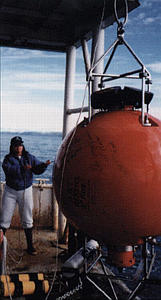
Shari Vaughn lowering a device loaded with acoustic transmitters and transducers.
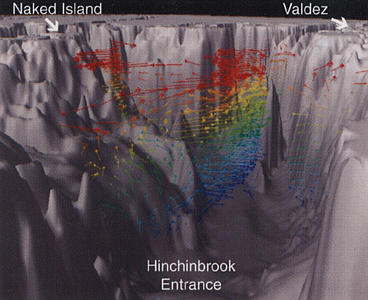
Three dimensional current flow patterns in Prince William Sound, measured by an Acoustic Doppler Current Profiler. This view is looking north into the Sound from Hinchinbrook Entrance. (Photos from the Prince William Sound Oil Spill Recovery Institute brochure).
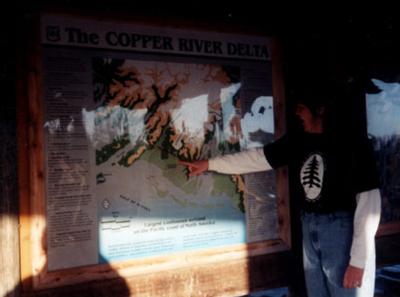
Nancy Bird, Vice President of the Prince William Sound Science Center, explains the physiography of the Copper River Delta.

Shari Vaughn, physical oceanographer with the Prince William Sound Science Center.
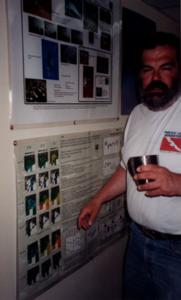
Tom Kline explains his work with stable isotope analysis as a tool for determining foraging habits of fish.
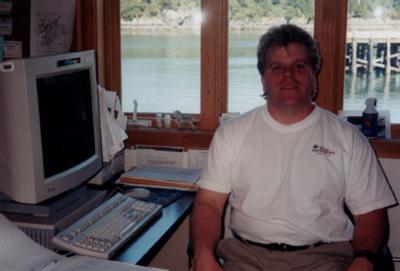
Jay Kirsch, electrical engineer and Project Leader of the Sound Ecosystem Assessment (SEA) project.
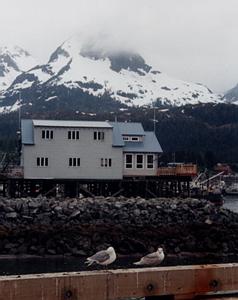
The Prince William Sound Science Center in Cordova, Alaska.
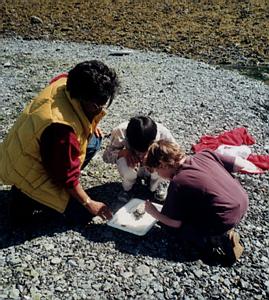
Here I am working with some of the students in the environmental science camp.

Belle Mickelson instructs campers about the intertidal zone.
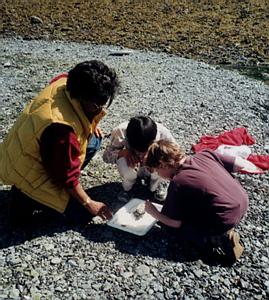
Here I am working with some of the students in the environmental science camp.
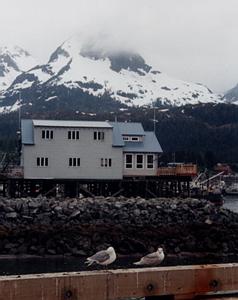
The Prince William Sound Science Center.

Belle Mickelson instructs campers about the intertidal zone.
Contact the TEA in the field at
.
If you cannot connect through your browser, copy the
TEA's e-mail address in the "To:" line of
your favorite e-mail package.
|
